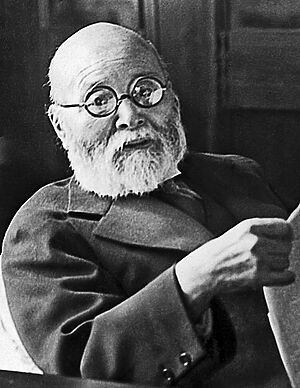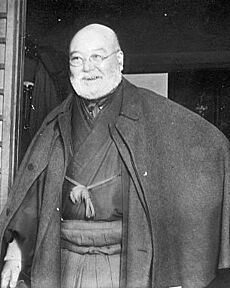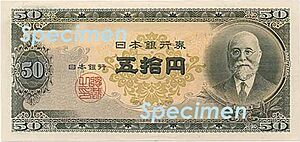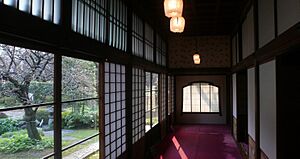Takahashi Korekiyo facts for kids
Quick facts for kids
Takahashi Korekiyo
|
|
|---|---|
|
高橋 是清
|
|
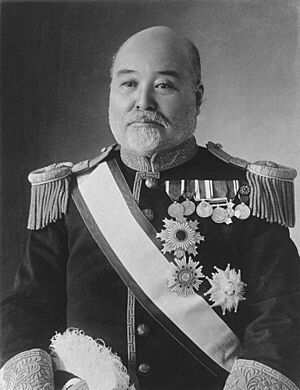 |
|
| Prime Minister of Japan | |
| In office 15 May 1932 – 26 May 1932 Acting |
|
| Monarch | Hirohito |
| Preceded by | Inukai Tsuyoshi |
| Succeeded by | Saitō Makoto |
| In office 13 November 1921 – 12 June 1922 |
|
| Monarch | Yoshihito |
| Regent | Hirohito |
| Preceded by | Uchida Kōsai (Acting) |
| Succeeded by | Katō Tomosaburō |
| Member of the House of Peers | |
| In office 29 January 1905 – 24 March 1924 |
|
| Member of the House of Representatives for Iwate 1st District |
|
| In office 10 May 1924 – 21 January 1928 |
|
| Personal details | |
| Born | 27 July 1854 Edo, Japan |
| Died | 26 February 1936 (aged 81) |
| Cause of death | Assassination (gunshot wound) |
| Resting place | Tama Reien Cemetery, Fuchū, Tokyo |
| Political party | Rikken Seiyūkai |
| Spouse | Takahashi Sina (1865–1936) |
| Signature |  |
Viscount Takahashi Korekiyo (born July 27, 1854 – died February 26, 1936) was an important Japanese politician. He served as the prime minister from 1921 to 1922. He was also the Minister of Finance for many years. He was a member of the House of Peers and led the Bank of Japan.
Takahashi helped Japan grow a lot in the early 1900s. He created Japan's first patent system. He also got money from other countries to help Japan in the Russo-Japanese War. Later, during the Great Depression, he made some big financial decisions. He stopped using the gold standard and lowered interest rates. He also used the Bank of Japan to help the government spend more money.
In 1935, he decided to cut government spending. This made some people in the Japanese military very angry. They killed him in February 1936. Many people say Takahashi's policies helped Japan recover from the Depression. However, after he died, prices went up a lot. This happened because his successors were afraid to stop funding the government.
Contents
Early Life and Education
Takahashi was born in Edo, which is now Tokyo. This was when Japan was still ruled by the Tokugawa shogunate. He was the son of a court painter. Later, he was adopted by a low-ranking samurai family.
He learned English and about American culture. He studied at a private school run by James Curtis Hepburn. In 1867, he traveled to Oakland, California, in the United States. He worked there as a laborer. Some stories say he went to study but was tricked and had to work hard to return to Japan.
A Busy Career
When Takahashi returned to Japan in 1868, he taught English. He became the first headmaster of the Kyōritsu Gakkō high school in Tokyo. At the same time, he worked for the government. He worked in the Ministry of Education. Then he moved to the Ministry of Agriculture and Commerce.
He became the first chief of the Bureau of Patents. This department was part of the Ministry of Agriculture and Commerce. He helped set up Japan's system for patents. A patent protects new inventions, so others can't copy them without permission. At one point, he left his government jobs. He went to Peru to try to start a silver mining business, but it did not succeed.
In 1892, Takahashi started working at the Bank of Japan. His skills were quickly noticed. He became the vice-president of the bank in 1898.
Helping Japan in War
During the Russo-Japanese War (1904–1905), Takahashi got loans from other countries. These loans were very important for Japan to fight the war. He met with an American banker named Jacob Schiff. Schiff helped Japan get half of its loans from the U.S. He also got loans from the Rothschild family in Britain.
Because of this success, he was chosen to join the House of Peers in 1905. This was a part of Japan's parliament. In 1906, he became the president of the Yokohama Specie Bank. He was given the title of baron in 1907. From 1911 to 1913, Takahashi was the Governor of the Bank of Japan.
Becoming a Political Leader
In 1913, Prime Minister Yamamoto Gonnohyōe made Takahashi the Minister of Finance. Takahashi then joined the Rikken Seiyūkai political party. He became Finance Minister again in 1918 under Prime Minister Hara Takashi. In 1920, his title was raised to viscount.
After Prime Minister Hara was killed in 1921, Takahashi became both Prime Minister and the leader of his party. He was the second Christian Prime Minister in Japan's history. His time as Prime Minister lasted less than seven months. This was mainly because he found it hard to control the different groups in his party. He did not have a strong base of support within the party.
After stepping down as Prime Minister, Takahashi remained the president of his party. In 1924, he left the House of Peers. He was then elected to the Lower House of Japan's parliament. When Katō Takaaki became prime minister in 1924, Takahashi became the Minister of Agriculture and Commerce. He split this department into two new ministries: the Ministry of Agriculture and Forestry and the Ministry of Commerce and Industry. Takahashi left the Rikken Seiyūkai party in 1925.
Later Life and Death
Takahashi served as Finance Minister again under several prime ministers. These included Tanaka Giichi (1927–1929), Inukai Tsuyoshi (1931–1932), Saitō Makoto (1932–1934), and Okada Keisuke (1934–1936). He worked to help Japan recover from the Great Depression of 1929. He made big changes to money and spending policies. In December 1931, he stopped using the gold standard. This meant the value of Japan's money was no longer directly tied to gold. He also allowed the government to spend more money than it collected in taxes.
His policies were very successful. However, his decision to cut military spending in 1935 made many in the military angry. He was one of several people killed by rebelling military officers. This happened during the February 26 Incident in 1936. His grave is in Tama Reien Cemetery in Fuchū, Tokyo. Takahashi was the last former Japanese prime minister to be killed until Shinzo Abe's death in 2022.
Honours and Titles
Takahashi Korekiyo received many honours during his life:
- He was made a Baron in 1907.
- He was made a Viscount in 1920.
- He received the Grand Cordon of the Order of the Sacred Treasure in 1906.
- He received the Grand Cordon of the Order of the Rising Sun in 1920.
- He received the Grand Cross of the Légion d'honneur from France in 1924.
- He received the Grand Cordon of the Order of the Paulownia Flowers in 1927.
- After his death, he was given the Grand Cordon of the Order of the Chrysanthemum in 1936.
Legacy
- Takahashi's picture appeared on a 50 Yen banknote in 1951. He is the only former president of the Bank of Japan to be on a Japanese banknote.
- Part of Takahashi's old home in Tokyo is now a memorial park. Another part of his house is preserved at the Edo-Tokyo Open Air Architectural Museum.
- His economic ideas during the Great Depression were similar to those of a famous economist named John Maynard Keynes. Keynes published his theories a few years later. Some believe Takahashi's success influenced Keynes' ideas.
- Ben Bernanke, a former head of the U.S. Federal Reserve, said Takahashi "brilliantly rescued Japan from the Great Depression". Japanese Prime Minister Shinzō Abe also said Takahashi inspired his economic policies.
- However, some, like former Bank of Japan president Masaaki Shirakawa, have called Takahashi's policies of the central bank helping the government a "bitter experience." In 1982, the Bank of Japan itself called his Depression-era policies "the bank's biggest mistake in its 100-year history."


